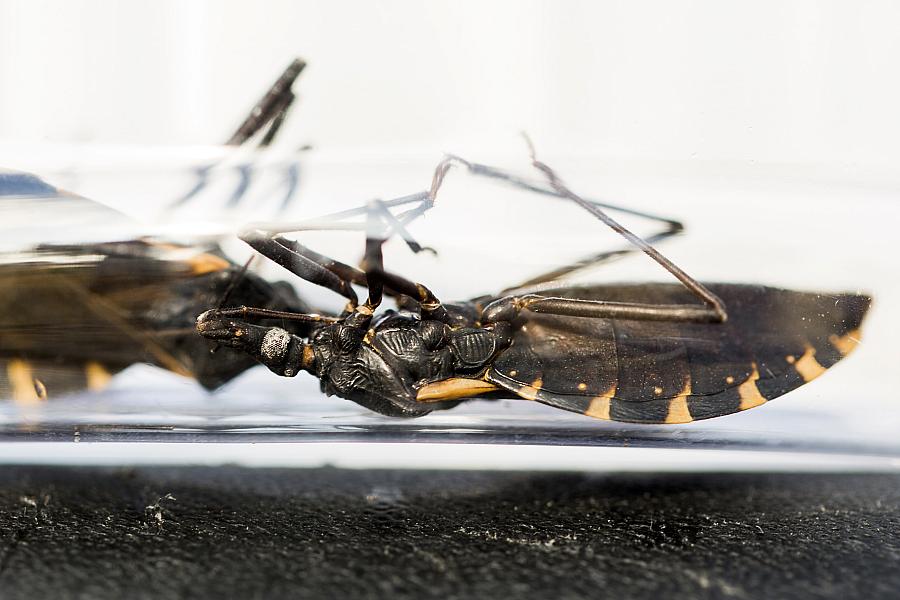How one reporter put neglected tropical diseases on Texans’ radar

The kissing bug can spread the parasite that causes Chagas disease. (Photo by Smiley Pool/The Dallas Morning News)
Some infectious diseases get all the attention. The Zika virus has been hogging the limelight recently. Before that, it was Ebola. But another group of diseases rarely make the news in the U.S. despite the fact that an estimated 12 million Americans are infected.
Those infections are neglected tropical diseases and include Chagas disease, toxocariasis, leishmaniasis and others. They cause debilitating illness, disfigurement and even death. By some estimates, between 300,000 and 1 million Americans are infected with Chagas disease. One third will suffer irreversible heart disease.
The National Health Journalism Fellowship supported my reporting on tropical diseases in Texas, which culminated in an interactive series for The Dallas Morning News that saw 67,000 unique visitors in its first two days online.
The four-part series answered four questions: Which neglected tropical diseases are in the U.S? Who is at risk of infection? What’s it like for Texans — human and canine — who live with these diseases? And why is the U.S. blood supply not adequately screened for Chagas disease?
Here’s what I learned while reporting this series:
1) Partner with other outlets to further the reach of your story.
At the Fellowship workshop in Los Angeles last summer, Cole Goins from The Center for Investigative Reporting said: “If you’re worried about another media outlet telling your story, why?” Goins encouraged us to tell our stories in a collaborative manner, in as many ways as we could think of, and across as many platforms as possible.
At The Dallas Morning News we have an established partnership with KXAS-TV, the local NBC affiliate, and a track record of award-winning joint investigations. If your newsroom doesn’t have that kind of partnership, consider building one. Even a temporary partnership will get your reporting in front of a wider audience. For this project, we linked to each other’s stories, batted ideas off one another and, at dallasnews.com, embedded the TV segments into the online series.
As well as distributing my Fellowship reporting in both The Dallas Morning News and KXAS-TV, I gave a heads up to our local NPR station, KERA, just before the series ran. An hour-long radio discussion about the Fellowship project hopefully raised awareness about tropical diseases in Texas and may have helped drive readers to the series.
2) Empower your audience.
We looped into a local citizen science project so that people who now knew how to identify the bugs that spread Chagas disease after reading our stories could send the critters into a lab at Texas A&M University’s College of Veterinary Medicine for testing. Experts there dissected the bugs, tested for the parasite, and were able to offer advice to anyone who may have been bitten.
Be aware of the potential impact of your reporting. The lab told us that after the series went online and aired on TV, they were inundated with phone calls, emails and bug specimens. And even four months later, our team is receiving emails from people who say they have found kissing bugs and have been bitten.
3) Experts are closer than you think.
Texas is home to the National School of Tropical Medicine, where world experts are working on vaccines to protect against neglected diseases (what they refer to as “diseases that keep poor people poor”). They’re an outspoken bunch and besides being leaders in this field, the experts connected us to other sources as well as patients living with these infections.
It turned out that articles I had read in medical journals a few years ago, the ones that had piqued my interest in tropical diseases in the U.S., were written by scientists in Texas. Of course we turned to sources from around the country, but the resources at hand in our state were immense and useful. The researchers at Texas A&M University even made this great interactive map that showed where kissing bugs have been found in Texas.
4) It won’t always work out the way you imagine.
I wanted to highlight the experiences of people with neglected tropical diseases who were living in poverty, since data show poor people are most at risk of infection and more likely to suffer long-term health effects.
Despite trips to county health clinics, calls to nonprofits and trying out a host of different strategies that I talked through with mentoring editor Diana Sugg, I failed to give a voice to the people most impacted by neglected tropical diseases in Texas.
The main character in my story, Candace, is a middle-class, white woman. Her experiences and her voice are incredibly powerful and important but I felt that I failed as a reporter by not giving a platform to disenfranchised communities.
But readers had a different take. People who thought these infections only affect the poor said Candace’s story made them assess their own risk and understand that the impact of these infections is felt by Texans from all backgrounds.

